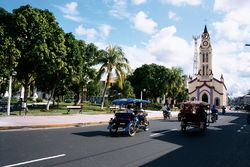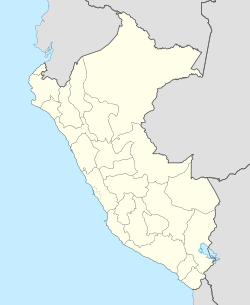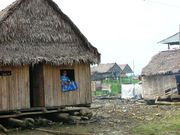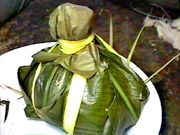Iquitos
| Iquitos | |||
|---|---|---|---|
 |
|||
|
|||
| Nickname(s): Capital de la Amazonía Peruana (Capital of the Peruvian Amazon) | |||
 Iquitos
|
|||
| Coordinates: | |||
| Country | |||
| Region | Loreto | ||
| Provinces | Maynas | ||
| Founded | 1750s | ||
| Districts | 4 Districts | ||
| Government | |||
| - Mayor | Salomón Abenzur Araujo | ||
| Area | |||
| - Total | 368.9 km2 (142.4 sq mi) | ||
| Elevation | 106 m (351 ft) | ||
| Time zone | PET (UTC-5) | ||
| Area code(s) | 65 | ||
| Website | www.munimaynas.gob.pe | ||
Iquitos (Spanish pronunciation: [iˈkitos]) is the largest city in the Peruvian rainforest, with a population of 370,962. It is the capital of Loreto Region and Maynas Province.
Located on the Amazon River, it is only 106 m (348 ft) above sea level, although it is more than 3,000 km (1,864 mi) from the mouth of the Amazon at Belém in Brazil, on the Atlantic Ocean. It is situated 125 km (78 mi) downstream of the confluence of the Ucayali and Marañón rivers, the two main headwaters of the Amazon River. Iquitos has long been a major port in the Amazon Basin. It is surrounded by three rivers: the Nanay, the Itaya, and the Amazon.
The city can be reached only by airplane or boat, with the exception of a road to Nauta, a small town roughly 100 km (62 mi) south. Ocean vessels of 3,000 tons or 9,000 tons[1] and 5.5 metres (18 ft) draft can reach Iquitos from the Atlantic ocean, 3,600 kilometres (2,200 mi) away.
Most travel within the city is via bus, motorcycle, or auto rickshaw (mototaxi, motocarro or motokar). Transportation to nearby towns often requires a river trip via peque-peque, a small public motorized boat.
The climate is hot and humid, with an average relative humidity of 85%. The wet season lasts from around November to May, with the river reaching its highest point in May. The river is at its lowest in October.
Contents |
History
European-Peruvians established Iquitos as a Jesuit mission to the indigenous peoples in the 1750s. In 1864 it started to grow when the settlers created the Loreto Region and made Iquitos its capital. It is the seat of a Roman Catholic Apostolic Vicariate.[2]
Iquitos was known for its rubber industry through the rubber boom of the first decade of the 20th century; it attracted thousands of immigrants from around the world, mostly young, single men who hoped to make their fortunes in rubber. The rise of the automobile and related industries had dramatically increased the worldwide demand for rubber. Some men became merchants and bankers, and made their fortunes that way. Many of the European men married indigenous women and stayed in Peru the rest of their lives, founding ethnically mixed families. The immigrants brought European clothing styles, music and other cultural elements to Iquitos.
Among the unique communities formed by the 19th-century rubber boom immigration was one of Sephardic Jews from Morocco. Many of the men married Peruvian women and made families in Iquitos. They established a synagogue and the Jewish Cemetery. By the end of the 20th century, four or five generations later, most descendants were no longer practicing Jews. In the 1990s, a descendant of a Jewish settler undertook serious study of the religion and began to revive Judaism among his family, friends, and other Sephardim descendants. After years of study, with the help of a sympathetic Conservative rabbi in Lima and another from Brooklyn, New York, eventually a few hundred people learned and practiced and converted. (Conversion was necessary as their mothers were not Jewish.) Many of the converts emigrated to Israel under its "right of return" policy.[3]
The wealthiest Europeans built great mansions in the late 19th century, some of which survive. Casa de Fierro (Spanish for the Iron House) was designed by Gustave Eiffel, designer of the Eiffel Tower. After rubber seeds were smuggled out of the country and began to be cultivated in quantity elsewhere, the Peruvian boom came to an end. The city is still an important trading port in the Amazon basin.
Economy
Iquitos has become important in the shipment of lumber from the Amazon Rainforest to the outside world. Other industries include oil, rum and beer and camu-camu cultivation. Camu-camu fruit contain 45% more vitamin C than oranges.
The city offers modern amenities for the residents and tourists in the area. It attracts people wanting to learn more about the Amazon Basin and indigenous culture, among others.
Education
Iquitos is home to numerous research projects on ecology related to ornithology and herpetology. Cornell University owns a field station dubbed the Cornell University Esbaran Amazon Field Laboratory. Founded in July 2001 under the direction of Dr. Eloy Rodriguez, the facility is dedicated to education, conservation, and the discovery of novel medicinal compounds from applied field chemoecology.
The field lab strives to survey and catalog the biological diversity found along the Yarapa River Basin. It provides researchers with field experience in the broad range of disciplines necessary for this task. Another major goal is to explore value-added derivatives of biodiversity. This includes both tangible returns, in the form of new discoveries in the biomedical and related sciences, as well as less tangible goods, such as the promotion of ecotourism and an ecological ethic. They work to ensure benefits to the local communities, and to participating students and researchers.
Tourism
Iquitos is home to the prominent Peruvian conservation research organization, Project Amazonas. It has three biological stations on tributaries of the Amazon, which sometimes allow visitors. Scientists, students, and tourists fly into Iquitos, where they transfer to boats for the remainder of their travel to the Project's research stations.
Iquitos has a growing reputation as a tourist destination, especially as a base for tours of the Amazon rainforest and the Pacaya-Samiria National Reserve. Other tourists travel downriver to Manaus, Brazil, the other rubber-industry city in the interior of the Amazon basin, and finally the Atlantic Ocean, which is 3,360 km (2,088 mi) away.
A boat tour of Belén is a common tourist attraction. Belén is a community east of Iquitos that can be accessed by foot and moto-carro, both in the dry and wet seasons. Many of the homes are tethered to large poles, from which they float upon the river's rising waters every year; some homes float year-round. Where the waters begin, there are often a few men with their boats who transport locals and tourists for a small fee. Belén's open-air market is also a tourist attraction. Most notable is the medicine lane, Pasaje Paquito, an entire block lined with vendors of local plant (and animal) medicines, who stock everything from copaiba to chuchuwasai.

Within the Belén open-air market, there is an illegal trade in rainforest primates, parrots, and other wildlife that should be protected by the CITES treaty. Some of the small animals, marmosets, tamarins, spider monkeys, are purchased locally, but many tropical birds, primates, boas, and others are smuggled into the United States for the lucrative exotic pet trade, according to Kneidel and Kneidel and TRAFFIC: The Wildlife Trade Monitoring Network.
Ayahuasca tourism has increased in Iquitos in recent years. Some Westerners seek traditional shamanic experiences by using the visionary Amazonian medicinal tea. Although some reputable curanderos who can provide a safe context for such experiences, others do not have the specialised training or skills. Tourists are advised to use caution in such pursuits.
Iquitos is served by Crnl. FAP Francisco Secada Vignetta International Airport.
Universities
Iquitos has four universities: Universidad Nacional de la Amazonía Peruana (UNAP), the local state university; Universidad Particular de Iquitos (UPI), Universidad Científica del Perú (UCP), Universidad Peruana del Oriente (UPO) three private institutions. It is also home to the Instituto de Investigaciones de la Amazonía Peruana (IIAP), the Institute of Investigation of the Peruvian Amazon.
Sport
Colegio Nacional de Iquitos is an association football team based in Iquitos. In 2005 the city's association football community received the FIFA Fair Play Award as a result of being one of the five host cities for the 2005 FIFA U-17 World Championship.
Gastronomy

The Juane, or John, is one of the main dishes of cuisine of the Peruvian jungle. It is widely consumed during the Catholic Feast of San Juan (St. John), held on 24 June each year. The dish was named in honor of San Juan Bautista. The dish could have a pre-Columbian origin. With the arrival of the Spanish, missionaries popularized the Biblical story of Salome, John and Herodias. Some believe the dish's name comes from the reference to the head of San Juan.
Tacacho, a kind of jerky, is often served with chorizo and is typical of Iquitos as well as the Peruvian Amazon. It is widespread in the rest of the country. The term tacacho derives from the Quechua term, taka chu, which means beaten. Tacacho consumption varies depending on the region where it is made. In Madre de Dios and San Martin, many people eat tacachos for breakfast, while in other regions, it is a dish served at lunch or dinner. In the San Martín region, tacacho is included in the Christmas dinner. In the Amazon region of Ecuador, the dish is known as bolon. It has a counterpart in the Caribbean islands, where it is called mofongo.
In popular culture
- The movie Fitzcarraldo (1982) was filmed near Iquitos. The film was inspired by the real life rubber baron Carlos Fitzcarrald.
- The Fire Within: Jews in the Amazonian Rainforest (2008) is a documentary by Lorry Salcedo Mitrani about 19th-century Sephardic Jewish immigrants to Iquitos and the community they made, as well as the late 20th-century migration of some descendants to Israel.
Notable people from Iquitos
- César Calvo de Araujo, writer and painter, born in Yurimaguas near Iquitos (1910–1970).
- Carlos Fitzcarrald, entrepreneur and rubber baron active in Iquitos (1862 – 9 July 1897).
See also
- Iperu, tourist information and assistance
- Tourism in Peru
- Punchana
- Loreto Region
- Peruvian Amazon
- Rainforest
References
- ↑ Amazon uk.encarta.msn.com. Retrieved 1 October 2006. Archived 31 Oct. 2009.
- ↑ "Vicariate Apostolic of Iquitos, Catholic Hierarchy
- ↑ Lonni Salcedo Mitrani, The Fire Within: Jews in the Amazonian Rainforest, Ruthfilms, 2008
External links
- Municipalidad Provincial de Maynas - Maynas provincial municipality official website (Spanish)
- El Instituto de Investigaciones de la Amazonía Peruana (IIAP) (Spanish)
- Universidad Nacional de la Amazonia Peruana (Spanish)
- ikitos.com - La Comunidad Virtual de Iquitos, Perú Service and information website for and about Iquitos, with extensive tourism pages (Spanish and English)
- ACOBIA-DWAzoo Amazon Manatee Rescue Center, Iquitos, Peru
- NY Times article: Jews of Iquitos
- - The Iquitos Times English language monthly newspaper and website for Ex-pats living in Iquitos, Peru]
|
|||||
